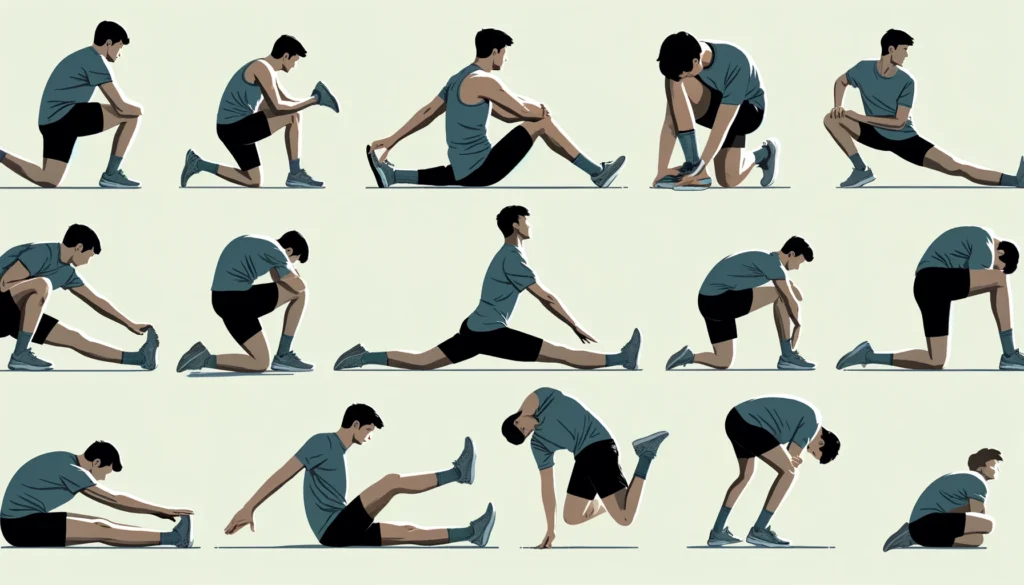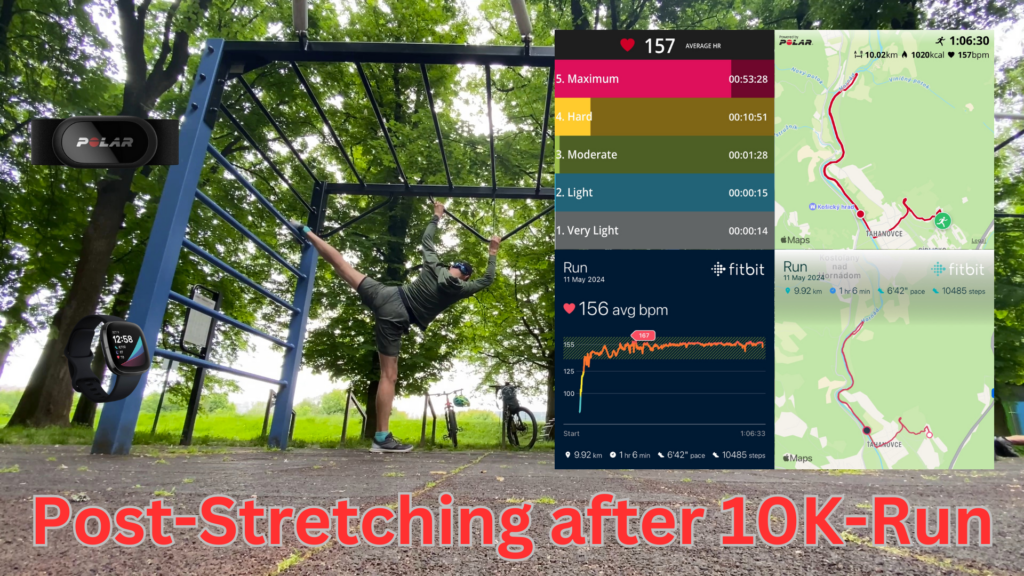Essential Post-Run Stretching Exercises
Welcome back to Taekwondo4Fitness! Today, we’re focusing on a crucial part of your running routine: post-run stretching. After completing a 10K run, it’s essential to relax your muscles, improve flexibility, and prevent injuries. Whether you’re a seasoned runner or just starting, these stretches will help you recover and stay in top form.
1. Hamstring Stretches
The hamstring stretch is a fundamental exercise to relieve tension and enhance flexibility in the back of your thigh. This stretch is particularly important for runners, as tight hamstrings can lead to discomfort and potential injuries.
How to Perform the Hamstring Stretch:
- Positioning: Sit comfortably on the ground with one leg extended straight in front of you. Bend the other leg at the knee, placing the sole of your foot against the inner thigh of the extended leg.
- Stretching: Slowly lean forward from your hips, keeping your back straight. Reach towards your toes on the extended leg. If you can’t reach your toes, aim for your ankle or shin—any stretch you feel in the hamstring is beneficial.
- Hold the Stretch: Once you feel a gentle pull in the back of your thigh, hold the position for 20-30 seconds. Breathe deeply and try to relax into the stretch, avoiding any bouncing or jerky movements.
- Switch Sides: After holding the stretch, return to the starting position and switch legs. Repeat the stretch on the opposite leg.
Tips for an Effective Hamstring Stretch:
- Avoid Rounding Your Back: Focus on hinging at the hips rather than curving your spine. This ensures the stretch targets the hamstring muscles effectively.
- Consistent Breathing: Maintain steady, deep breaths throughout the stretch to help your muscles relax and elongate.
- Progress Gradually: If you’re new to stretching, start with a shorter duration and gradually increase the time as your flexibility improves.
Incorporating the hamstring stretch into your post-run routine will help maintain muscle elasticity, reduce stiffness, and enhance your overall running performance. Make it a habit to perform this stretch regularly, and you’ll notice significant improvements in your flexibility and comfort during runs.
2. Quadriceps Stretches
The quadriceps stretch is a vital part of any post-run routine, helping to relieve tension and prevent injury in one of the most hardworking muscle groups during your run. Here’s how to do it effectively:
Instructions:
Stand on One Leg: Find your balance by standing on one leg. If needed, you can hold onto a wall or a sturdy object for support.
Pull Your Foot Towards Your Buttocks: Reach back with your hand and grab the ankle of the opposite leg, pulling your foot gently towards your buttocks. Make sure your knees are close together to maximize the stretch.
Maintain Good Posture: Keep your back straight and your core engaged. Avoid arching your lower back to ensure the stretch is focused on your quadriceps.
Hold the Stretch: Maintain this position for 20-30 seconds, feeling a gentle pull along the front of your thigh. Breathe deeply and relax into the stretch.
Switch Legs: Release your foot and return to a balanced standing position. Repeat the stretch on the opposite leg.
Benefits of the Quadriceps Stretch:
- Improves Flexibility: Regularly stretching your quadriceps helps maintain and improve their flexibility, which is crucial for a full range of motion during your runs.
- Reduces Muscle Tension: Post-run stretching helps to alleviate muscle tightness, reducing the risk of cramps and discomfort.
- Prevents Injuries: Keeping your quadriceps flexible can prevent strains and other injuries associated with tight muscles.
- Enhances Performance: Flexible and well-stretched muscles contribute to better running form and efficiency, enhancing your overall performance.
Incorporate the quadriceps stretch into your post-run routine to keep your legs strong, flexible, and ready for your next run. For more fitness tips and routines, explore our website and join our community at Taekwondo4Fitness!

3. Calf Stretches
Properly stretching your calves after a run is essential for maintaining flexibility and preventing tightness or injury. Here’s how to perform a calf stretch effectively:
1. Position Yourself:
- Stand facing a wall or a sturdy object you can push against for support.
- Place one foot in front of the other, ensuring your feet are parallel.
2. Execute the Stretch:
- Bend your front knee slightly while keeping your back leg straight.
- Press your back heel firmly into the ground. You should feel a gentle stretch in the calf muscle of your back leg.
3. Maintain and Hold:
- Hold this position for 20-30 seconds, breathing deeply and keeping your back heel on the ground.
- Avoid bouncing or sudden movements to prevent strain.
4. Switch and Repeat:
- After holding the stretch, switch legs and repeat the process with the opposite leg.
- Perform this stretch 2-3 times on each leg to ensure both calves are adequately stretched.
Benefits of the Calf Stretch:
- Prevents Muscle Tightness: Helps keep your calf muscles loose and flexible.
- Improves Circulation: Enhances blood flow to your lower legs, aiding in recovery.
- Reduces Risk of Injury: Regular calf stretching can decrease the likelihood of strains and other injuries.
Incorporating the calf stretch into your post-run routine will help you recover faster and maintain better overall muscle health. Remember, consistency is key to optimal results!
4. Hip Flexor Stretch
The hip flexor stretch is a vital exercise for runners as it targets the muscles at the front of the hip, which often become tight from prolonged running. Here’s a detailed breakdown of how to perform this stretch effectively:
Step-by-Step Instructions:
- Get into Position: Start by kneeling on one knee. Ensure your other foot is in front of you, creating a 90-degree angle at both knees. Your front knee should be directly above your ankle, and your back knee should rest comfortably on the ground.
- Align Your Hips: Square your hips to the front, maintaining a neutral spine. Engage your core muscles to stabilize your pelvis.
- Push Forward: Slowly push your hips forward until you feel a gentle stretch along the front of your hip and thigh of the kneeling leg. Avoid arching your lower back; the movement should come from your hips.
- Hold the Stretch: Maintain this position for 20-30 seconds. Breathe deeply, allowing your body to relax and deepen into the stretch.
- Switch Sides: Gently release the stretch, return to the starting position, and switch legs. Repeat the stretch on the other side, following the same steps.
Benefits of the Hip Flexor Stretch:
- Improved Flexibility: Regularly stretching your hip flexors enhances flexibility, which is crucial for a full range of motion during running.
- Injury Prevention: Tight hip flexors can lead to various issues, including lower back pain and hip injuries. This stretch helps prevent such problems by keeping your muscles supple.
- Better Posture: Stretching your hip flexors can improve your overall posture, reducing strain on your lower back and promoting a more balanced stance.
Incorporate the hip flexor stretch into your post-run routine to ensure your muscles remain flexible and strong. This simple yet effective exercise will contribute significantly to your recovery and overall running performance.
5. Lower Back Stretches
The lower back stretch is an excellent exercise for releasing tension and enhancing flexibility in your lumbar region. This simple yet effective stretch helps alleviate lower back pain, promotes relaxation, and aids in muscle recovery. Here’s how to perform the lower back stretch:
- Starting Position: Lie flat on your back on a comfortable, firm surface such as a yoga mat or carpet. Keep your knees bent and your feet flat on the ground. Your arms should be resting at your sides.
- Engage Your Core: Before starting the stretch, engage your core muscles. This will provide additional support to your lower back and ensure you perform the stretch correctly.
- Bring Knees to Chest: Slowly lift your feet off the ground and bring your knees towards your chest. Use your hands to gently hug your knees, pulling them closer to your chest. If you find it difficult to reach your knees, you can hold the back of your thighs instead.
- Hold the Stretch: Maintain this position for 20-30 seconds, focusing on deep, even breaths. As you inhale, feel your abdomen rise, and as you exhale, feel your body relax further into the stretch. This breathing technique enhances the stretch’s effectiveness and helps in muscle relaxation.
- Release and Repeat: After holding the stretch, slowly release your knees and lower your feet back to the ground. Repeat this stretch 2-3 times, or as needed, to fully relax your lower back.
Benefits of the Lower Back Stretch
Relieves Tension: This stretch is excellent for relieving tension that accumulates in the lower back muscles, especially after a long run. Running can put a lot of strain on your lower back, leading to tightness and discomfort. The lower back stretch helps to alleviate this tension, promoting a feeling of relief and comfort.
Enhances Flexibility: Regularly performing this stretch can greatly improve the flexibility and mobility of your lower back. Increased flexibility in this area allows for a greater range of motion, making your movements smoother and more efficient during your runs.
Prevents Injuries: Keeping your lower back muscles supple and flexible is key to reducing the risk of injuries. Tightness and strain in the lower back can lead to more serious issues, such as muscle strains or lower back pain. By incorporating this stretch into your routine, you help protect yourself from these potential problems.
Promotes Relaxation: The gentle nature of this stretch not only benefits your physical health but also promotes overall relaxation. Stretching helps to release endorphins, which can improve your mood and reduce stress. This dual benefit of physical and mental relaxation is essential for a holistic approach to well-being.
Incorporating the lower back stretch into your post-run routine will significantly contribute to your recovery process. It ensures that you stay flexible, injury-free, and ready for your next run. This simple yet effective stretch is a must-have in your fitness regimen, promoting long-term health and performance benefits.
Recommended Fitness Trackers
To optimize your running and recovery, consider using a reliable fitness tracker. Here are my top picks:
- Polar H10: Check it out here on Amazon.
- Fitbit Sense 2: Check it out here on Amazon.
For an in-depth review of the best fitness trackers in 2024, visit my blog post: Best Fitness Trackers in 2024: Path to Health
Disclaimer
As an Amazon Associate, I earn from qualifying purchases.
Stay active, stay healthy, and keep pushing your limits! For more fitness tips and routines, explore our website and join our community at Taekwondo4Fitness.






